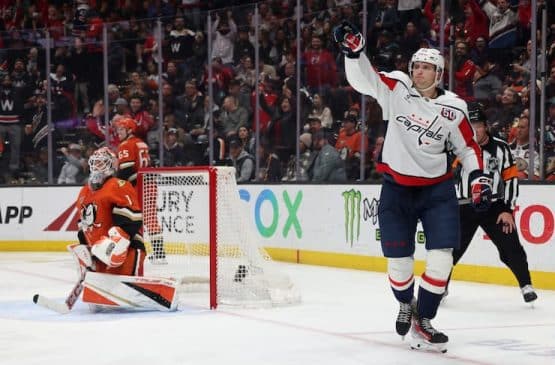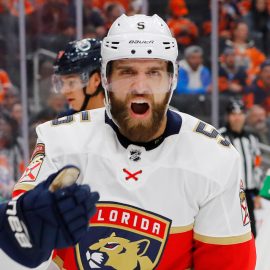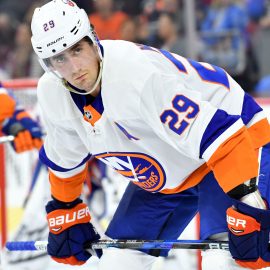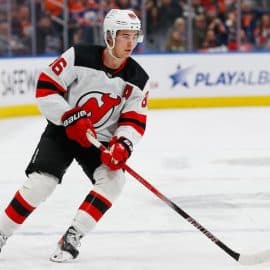After the first phase of the NHL’s Draft Lottery, the Ottawa Senators and the rest of the league had to wait until the conclusion of the NHL’s ‘Play-in’ round to fully realize which teams would participate in phase two of the Draft Lottery.
This is how the order stood after the first draft lottery was held:
- Placeholder
- Los Angeles
- Ottawa
- Detroit
- Ottawa
- Anaheim
- New Jersey
- Buffalo
For the Senators’ interest, the only matter that concerned them was the placement of the New York Islanders’ first round selection that they acquired in the Jean-Gabriel Pageau trade.
As much as I was hoping for the chaos theory that would have seen the Florida Panthers knock off the Islanders thereby allowing them to win phase two of the NHL’s Draft Lottery — securing Ottawa the Islanders’ 2021 selection when there is a reasonable chance that the Islanders could bomb — this scenario will sadly no longer play out.
In advancing past the Panthers, the Islanders’ 2020 first round pick now is expected to range in the 19th to 21st overall span provided, of course, that the Islanders don’t advance deeper into the postseason.
Thanks to the chaos created by a four-month layoff and using short five-game series to determine which teams could move on and qualify for the postseason, an influx of teams with some really good building blocks could be on the verge of adding Alexis Lafreniere to their core.
It is easy to resent the fact that the Islanders’ selection was not lower or that a really good team on the cusp of better things may be on the verge of adding a young and cost-controlled first overall selection who will step into their lineup next season.
At the same time however, given the calibre of some of the teams that lost in the play-in round, maybe this creates a bit of an opportunity for the Ottawa Senators.
In one of my more recent articles, I discussed the abundance of cap space that the Senators have and the likelihood that the organization will creatively leverage that to advance the team’s long-term interests.
Well, now that the Islanders’ pick is slated to fall in the latter half of the first round, I can’t help but wonder if the Senators may be able to use their cap space as a mechanism to help move that Isles pick up without having to use any of their stockpiled draft pick and prospect capital.
What the Senators and Pierre Dorion have to do is look at the teams that will slot ahead of their third first-round selection and determine whether there are any fits. Is there a team in that play-in loser category that would be willing to trade down in the first round if it meant they could dump bad money to the Senators?
Here is a reverse-ranking of the play-in round losers based on their points percentage who each have a 12.5 percent chance of landing Lafreniere tonight. Beside the points percentage column, I have include each team’s projected cap hit for the 2020-21 season via CapFriendly.com.
|
Rk |
Team |
Pts % |
Proj. Cap Hit |
Roster Size |
|
1 |
Minnesota |
.558 |
$65.3 |
17 |
|
2 |
Winnipeg |
.563 |
$65.9 |
13 |
|
3 |
New York Rangers |
.564 |
$68.0 |
16 |
|
4 |
Nashville |
.565 |
$72.2 |
17 |
|
5 |
Florida |
.565 |
$60.5 |
13 |
|
6 |
Toronto |
.579 |
$76.9 |
17 |
|
7 |
Edmonton |
.585 |
$71.4 |
17 |
|
8 |
Pittsburgh |
.623 |
$68.3 |
15 |
Minnesota
The Wild are in one of those weird franchise development curves where they have some decent pieces, but not enough elite talent to push them over the top. They also have some bad long-term money tied up to players in their mid-30’s like Zach Parise, Mats Zuccarello and Ryan Suter. There would possibly be room to make a deal here if any of those aforementioned players had less term on their deals, but each of the three are signed through the 2023-24 season.
Looking at the rest of the roster and the Wild’s cap situation and I just don’t think there’s much of a match, especially since if the Wild don’t win the lottery, they’ll be guaranteed the ninth overall selection.
Winnipeg
The Jets are an interesting mix in the sense that their forward core is relatively young and a few of their older veterans like Mathieu Perreault and Blake Wheeler are still efficient players.
With almost $66 million already counted against the cap however and only 13 skaters pencilled in on the roster, the Jets have a lot of work to do to bolster their blue line and shore up their forward depth.
Unfortunately, the Jets simply do not have a ton of bad money tied up in redundant players right now and like the Wild, if they don’t win tonight’s lottery, they will possess a top-10 pick.
New York
After having three top-10 selections in the past three years, the New York Rangers have supplemented their roster with some mid-20’s talent through trade (Mika Zibanejad, Jacob Trouba, Anthony Deangelo) and free agency (Artemi Panarin).
It remains to be seen how patient the Rangers will be with their approach, but this is a roster that they hope will make waves over the next few years, maybe even as early as next season. Knowing that, it is possible that the Rangers could aggressively look to dump the one-year and $5.7 million owed to Marc Staal or reinvest the cap space (one year, $8.5 million) dedicated to the last year of Henrik Lundqvist’s deal.
Both players are protected by no-movement clauses, however and given their cap situation, it’s easy to envision the organization just letting these players ride out the last years of their respective deals in New York. The only way the Rangers could think about moving either of these deals is if the organization intends to be aggressive in unrestricted free agency.
Nashville
The Senators and Predators rather infamously got together to make a trade, allowing the Senators to move up their first-round pick in 2008.
On the advice of their Swedish scout, Anders Forsberg, the Senators dealt the 18th overall selection and a third-round pick in 2009 to the Predators so they could selection the diminutively statured Erik Karlsson with the 15th overall pick.
Are the Senators and Predators a match 11 years later?
I doubt it.
The Predators have the bulk of their core locked in for the foreseeable future and although there is bad money invested in a number of good but not great forwards who are entering their 30’s, it makes no sense for the Senators to reunite with Kyle Turris or Matt Duchene considering the term left on their deals.
Florida
With Dale Tallon and the Panthers finally going their separate ways, it looks like the organization will be looking to inexpensively retool this group.
Reports indicate that the Panthers are looking to cut salary next season and with Evgeni Dadonov and Mike Hoffman both eligible for unrestricted free agency, neither is expected back next season.
If there is a deal to be made with the Panthers, expect it to involve prospects and picks going the other way.
Carolina (via Toronto)
If the Leafs do not have the ping pong balls go their way tonight, their protected lottery pick gets transferred to the Carolina Hurricanes as part of the Patrick Marleau trade from last summer.
According to CapFriendly.com, the Canes have 16 skaters signed through next season for a projected cap hit of $72.4 million.
It’s an economical roster that the Hurricanes have put together and with Eric Tulsky and his staff working diligently behind the scenes in that front office, it’s a smart group that will identify and mitigate risk.
The biggest question for the Hurricanes is whether they will make a splash and try and augment this roster with another good piece before Dougie Hamilton hits unrestricted free agency at the conclusion of the 2020-21 season. Although he could sign an extension, will the Canes look to throw a haymaker while he’s still pretty inexpensive?
If they do, freeing up more money by dealing the one-year and $3.375 million cap hit belonging to Ryan Dzingel may make sense. It’s not a prohibitively expensive deal, but it’s money that could be reallocated to address another hole. Swapping picks and taking on that contract may not be enough to get a deal done, but it may help form the basis of a trade package if the Senators are willing.
Edmonton
The Oilers are an interesting case because it is such a flawed roster that has been constructed around Connor McDavid and Leon Draisaitl.
The Oilers have 17 skaters and a little more than $10 million in cap space to round out their roster. Trading Kris Russell or James Neal would help alleviate some of their financial concerns, but with three seasons left on Neal’s term, he doesn’t possess the kind of short-term problem that the Senators should be looking to acquire.
Russell on the other hand is the kind of ineffectual player that the Oilers could be looking to move on from. And at 33 years of age and one-year left on a deal that only costs $1.5 million in real salary (cap hit of $4.0 million and a $1.0 million signing bonus that has already been paid), Russell is really an inexpensive option who could be a one-year placeholder replacing Ron Hainsey’s veteran experience and ice time.
Russell is protected by a 15-team trade list in 2020-21 however, so it’s possible that Ottawa will be on that list.
Pittsburgh
For an organization that is perennially in the conversation of teams that should vie for the Eastern Conference crown, it is pretty impressive how the Penguins have continued to handle their cap situation.
With 15 skaters signed at $68.2 million, the Penguins’ core is already locked up and they only really have to worry about how much money their goaltenders (Matt Murray and Tristan Jarry are both RFAs) will earn on their next contracts.
Under any circumstance, the Penguins should really be looking to offload the three years remaining on Jack Johnson’s $3.25 million AAV contract, but that’s the mid-range term that probably won’t appeal to the Senators at the cost of only moving the Isles pick up three or four spots.
Conclusions…
Unfortunately for the Senators, most of their prospective trade partners with bad cap situations advanced past the play-in round.
Chicago, Columbus and Vancouver could have presented some intriguing trade scenarios for the Senators, but if all three teams bow out in the first round, the Senators could always circle back and kickstart some discussions.
For Columbus, they could be eager to dump Brandon Dubinsky’s one-year and $5.85 million salary and cap hit. Chicago may be willing to put together a Godfather’esque package together in an attempt aggressively try to dump the remainder of Brent Seabrook’s deal (four years, $6.785 AAV). After a concussion limited Andrew Shaw to 23 games this season, Chicago may try and move the two years remaining on his contract to reallocate $3.9 million of cap space. Vancouver may try and free up space by moving Loui Eriksson, Micheal Ferland, Antoine Roussel or Jay Beagle.
Even a stacked Philadelphia Flyers team may try to create some flexibility by moving the one-year and $5.75 million owed to Matt Niskanen in 2020-21.
Ultimately, there are going to be opportunities for the Senators to explore and as I’ve outlined, there could be some deals to be had if the Senators open themselves up to the possibility of using a prized resource, cap space, to improve their draft position – whether that is the Islanders’ first round selection or even one of the team’s second round picks.
Doing so will require an investment of money and for an organization that has routinely made bad personnel decisions that have cost the franchise millions, this avenue can represent a better investment.
The organization has said it will spend money at some undisclosed point in the future when the team is better positioned to contend, but spending this kind of money to take advantage of teams in cap hell could help improve this team’s future.
I want to see the Senators find creative ways to make their organization better.
All it will take is some money and if they’re unwilling to spend it (or worse, find ways to potentially circumvent the cap floor like they did last offseason), they should be held accountable for it.
Add The Sports Daily to your Google News Feed!






